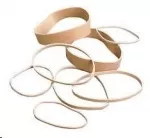May 17, 2017

Rubber, which comes from latex extracted from the Hevea brasiiensis, otherwise known as the rubber tree, has been used for centuries. The first known civilization to use rubber was the Olmec, who flourished in what is now Mexico. The Olmec, meaning “rubber people” in the local Nahuatl language of the Aztecs, used their rubber extraction and production knowledge to create a rubber ball. Dating as far back as 1600 BC, the Olmec’s creation is one of the earliest examples of a ball used for sport in history.
The all-important rubber band ball, for which we are indirectly indebted to the great Olmec people, wouldn't enter the history books until much later. Rubber first arrived in Europe in the 1730s, when the French explorer Charles Marie de La Condamine returned with samples from South America—where the rubber tree is native. Later that century, the elastic extract appeared in England, where it was celebrated for its capacity to erase pencil markings and given the name rubber by a chemist named Joseph Priestley.
The precursor to the modern rubber band appeared soon after, as rubber bottles—shipped to England from South America—were sliced into strips by an Englishman named Thomas Hancock to be used as garters and waistbands. The final step took place back in the New World by an American inventor named Charles Goodyear, who in 1839, discovered the critical vulcanization process which greatly improves rubber’s tensile strength, allowing for the elasticity necessary to make such marvels as the rubber band ball.
The creation of record-breaking rubber band balls, undoubtedly the pinnacle of rubber-based achievements, is seemingly an art form dominated by the Americans. In 1999, John Bain of Delaware made a rubber band ball of enormous proportions. With a circumference of over 4.5 meters (15 feet), Bain’s record-setting ball weighed over 1,300 kilograms (3,000 pounds). Next came a Scotsman named Steve Milton who—completed with a corporate sponsor—set the record in 2006 with a ball weighing in access of 2,100 kilograms (4,600 pounds).
However, a 28-year-old Floridian named Joel Waul trumped them all. By 2008, after five years of production, Waul had set the Guinness World Record with a whooping 4,363 kilogram (9,400 pound) creation, comprised of over 700,000 rubber bands. The ball, which had previously sat on his driveway in the town of Lauderhill, Florida, was purchased by Ripley’s Believe It or Not in 2009.
With his record, Waul added another milestone to the great history of rubber, stretching our imagination once more. Both the Olmec people and Mr Perry would have been proud.
Image: Assorted rubber bands - clipartpanda.com
Share this article with friends!
Tags:
#rubber#bands,#stephen#perry,#starzpsychics.com,#starz#advisors

